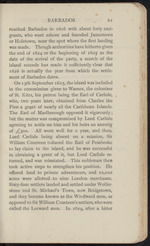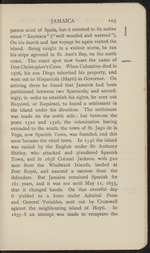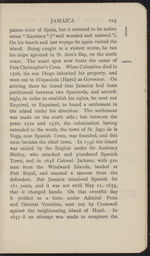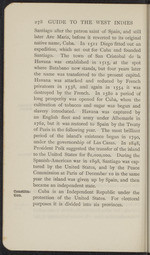| 1 |
 |
“...about forty emi-
grants, who went ashore and founded Jamestown
or Holetown, near the spot where the first landing
was made. Though authorities have hitherto given
the end of 1624 or the beginning of 1625 as the
date of the arrival of the party, a search of the
island records has made it sufficiently clear that
1626 is actually the year from which the settle-
ment of Barbados dates.
On 13th September 1625, the island was included
in the commission given to Warner, the coloniser
of St. Kitts, his patron being the Earl of Carlisle,
who, two years later, obtained from Charles the
First a grant of nearly all the Caribbean Islands.
The Earl of Marlborough opposed it vigorously;
but the matter was compromised by Lord Carlisle
agreeing to settle on him and his heirs an annuity
of ^300. All went well for a year, and then,
Lord Carlisle being absent on a mission, Sir
William Courteen induced the Earl of Pembroke
to lay claim to the island, and he was successful
in obtaining a grant of it, but Lord Carlisle...”
|
|
| 2 |
 |
“...JAMAICA 105
patron saint of Spain, but it reverted to its native
name “Xaymaca” (“well wooded and watered”).
On his fourth and last voyage he again visited the
island. Being caught in a violent storm, he ran
his ships aground in St. Ann’s Bay, on the north
coast. The exact spot now bears the name of
Don Christopher’s Cove. When Columbus died in
1506, his son Diego inherited his property, and
went out to Hispaniola (Hayti) as Governor. On
arriving there he found that Jamaica had been
partitioned between two Spaniards, and accord-
ingly, in order to establish his rights, he sent out
Esquivel, or Esquimel, to found a settlement in
the island under his direction. The settlement
was made on the north side; but between the
years 1520 and 1526, the colonisation having
extended to the south, the town of St. Jago de la
Vega, now Spanish Town, was founded, and this
soon became the chief town. In 1596 the island
was raided by the English under Sir Anthony
Shirley, who attacked and plundered Spanish...”
|
|
| 3 |
 |
“...JAMAICA i os
patron saint of Spain, but it reverted to its native
name “Xaymaca” (“well wooded and watered”).
On his fourth and last voyage he again visited the
island. Being caught in a violent storm, he ran
his ships aground in St. Ann’s Bay, on the north
coast. The exact spot now bears the name of
Don Christopher’s Cove. When Columbus died in
1506, his son Diego inherited his property, and
went out to Hispaniola (Hayti) as Governor. On
arriving there he found that Jamaica had been
partitioned between two Spaniards, and accord-
ingly, in order to establish his rights, he sent out
Esquivel, or Esquimel, to found a settlement in
the island under his direction. The settlement
was made on the north side; but between the
years 1520 and 1526, the colonisation having
extended to the south, the town of St. Jago de la
Vega, now Spanish Town, was founded, and this
soon became the chief town. In 1596 the island
was raided by the English under Sir Anthony
Shirley, who attacked and plundered Spanish...”
|
|
| 4 |
 |
“...Constitu-
tion.
278 GUIDE TO THE WEST INDIES
Santiago after the patron saint of Spain, and still
later Ave Maria, before it reverted to its original
native name, Cuba. In 1511 Diego fitted out an
expedition, which set out for Cuba and founded
Santiago. The town of San Cristobal de la
Havana was established in 1515, at the spot
where Batabano now stands, but four years later
the name was transferred to the present capital.
Havana was attacked and reduced by French
privateers in 1538, and again in 1554 it was
destroyed by the French. In 1580 a period of
long prosperity was opened for Cuba, when the
cultivation of tobacco and sugar was begun and
slavery introduced. Havana was captured by
an English fleet and army under Albemarle in
1762, but it was restored to Spain by the Treaty
of Paris in the following year. The most brilliant
period of the island’s existence began in 1790,
under the governorship of Las Casas. In 1848,
President Polk suggested the transfer of the island
to the United States...”
|
|
